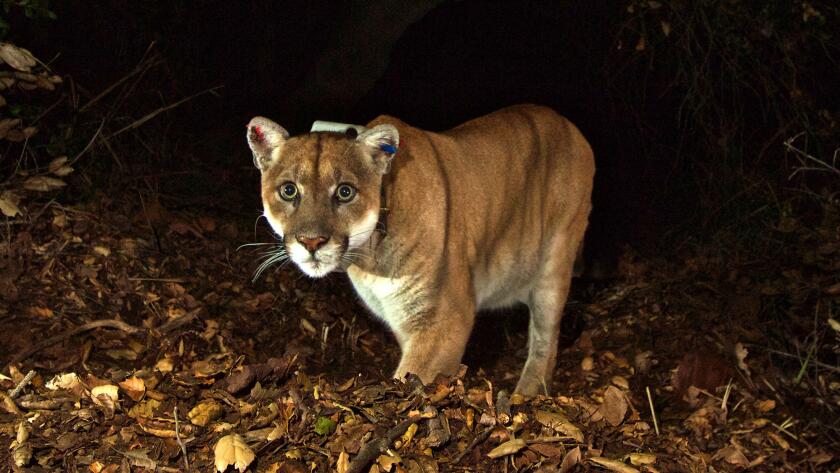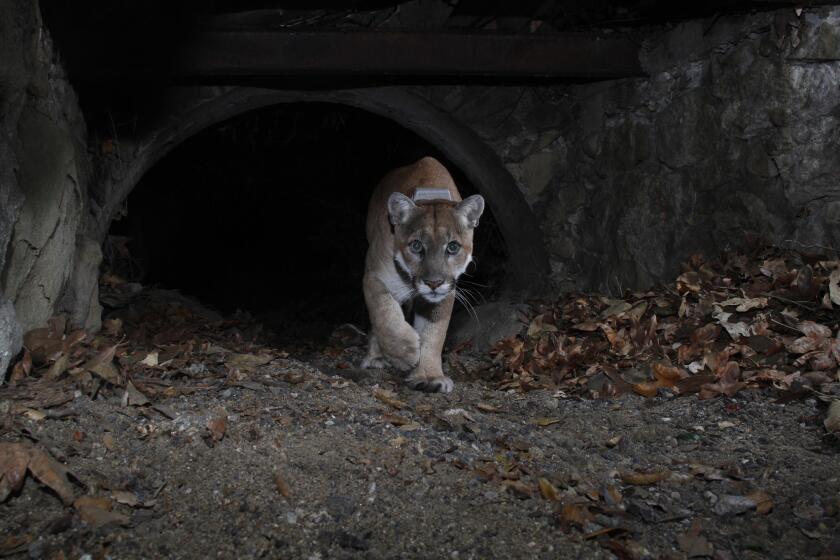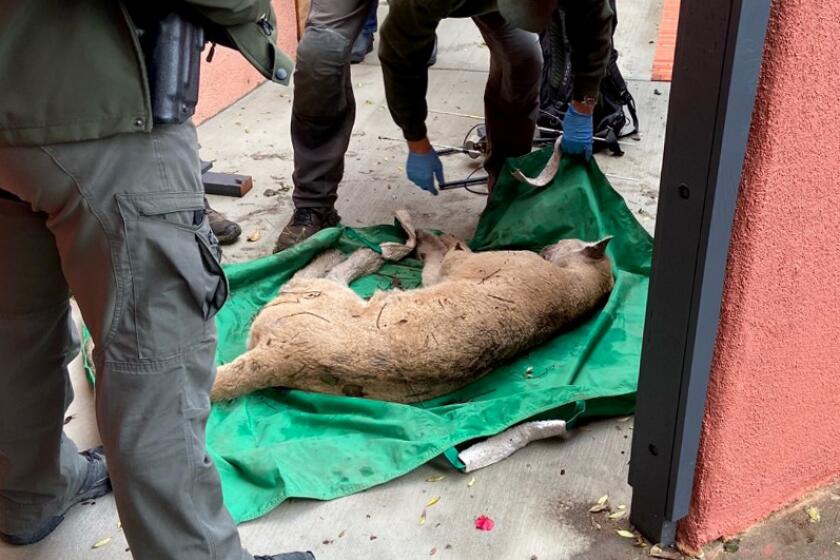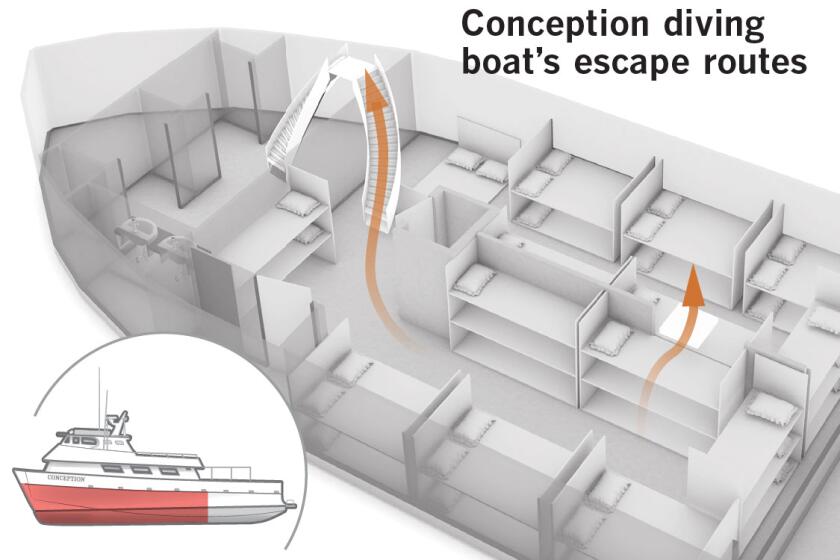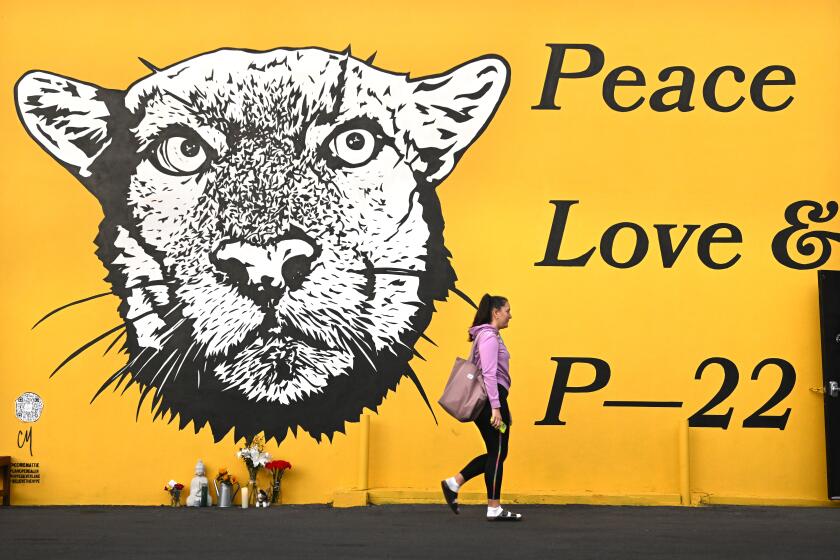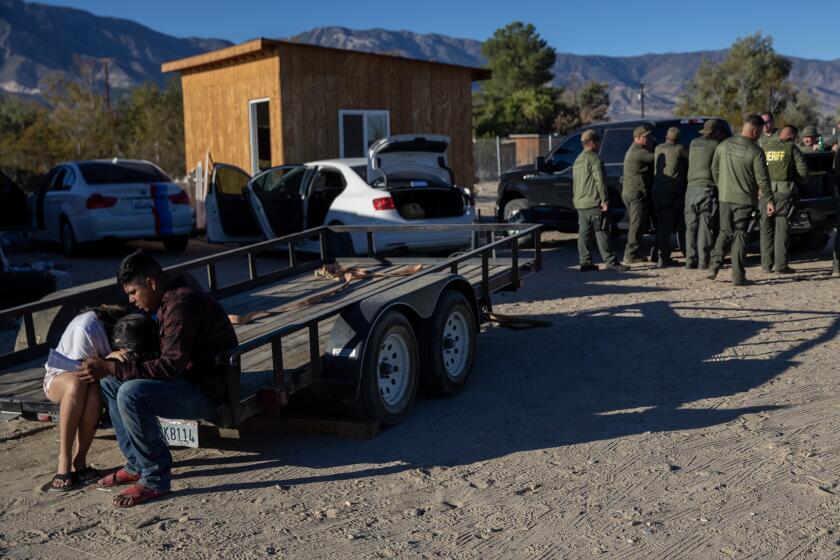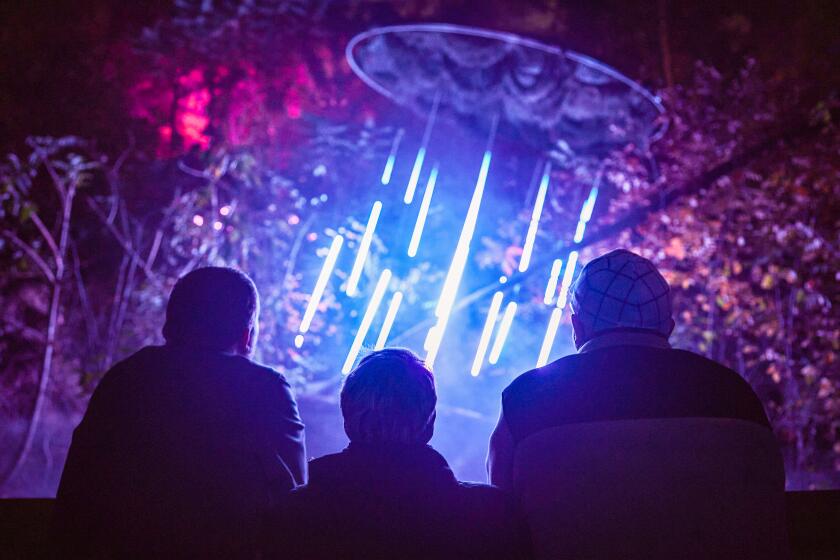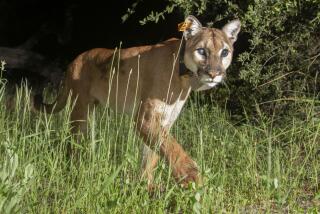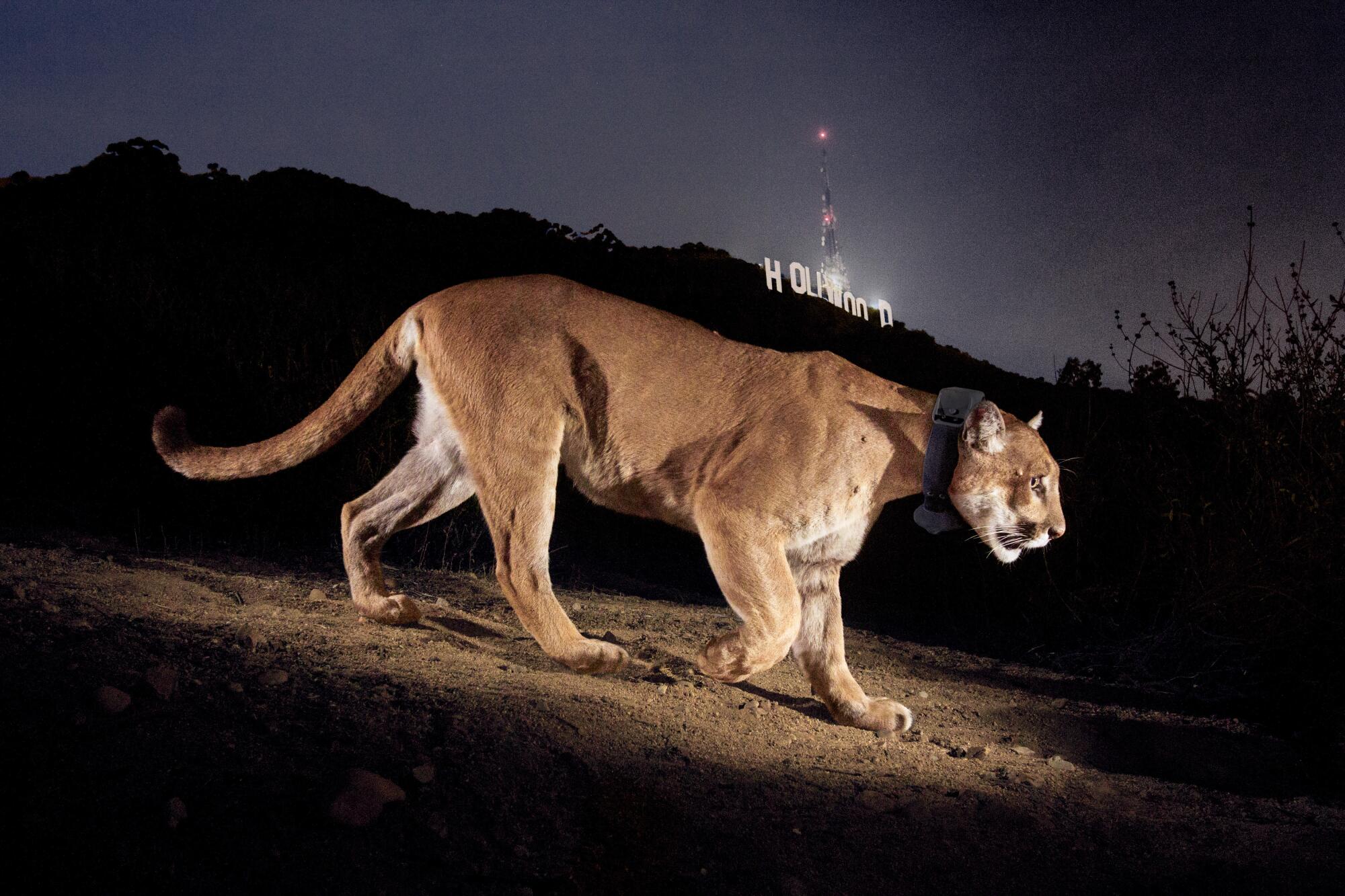
The mountain lion P-22, who lived in the heart of Los Angeles for more than a decade and became the face of an international campaign to save Southern California’s threatened pumas, was euthanized Saturday because of several long-term health concerns and injuries that likely stemmed from being hit by a car, officials said.
In a tearful news conference, wildlife biologists described multiple chronic illnesses that may have contributed to the mountain lion’s recent uncharacteristic behavior. The big cat of Griffith Park was “compassionately euthanized” at about 9 a.m., officials said.
“This really hurts, and I know that,” said Chuck Bonham, director of the California Department of Fish and Wildlife. “It’s been an incredibly difficult several days. And for myself, I’ve felt the entire weight of the city of Los Angeles.”
P-22, who has been euthanized due to severe injuries, was thought to be about 12 years old.
Officials with the National Park Service and the state’s wildlife department decided to capture and evaluate the mountain lion earlier this month after he began to exhibit increasing “signs of distress,” including three attacks on dogs in a month and several near-miss encounters with people walking in Los Feliz and Silver Lake.
The big cat was captured Monday in a backyard in Los Feliz, sedated and taken in for medical evaluation. The night before his capture, an anonymous caller had reported a vehicle collision with a mountain lion a few blocks south of Griffith Park, and P-22’s radio collar placed him nearby, officials said.
Health exams revealed that P-22 weighed about 90 pounds, a loss of nearly one-fourth of his usual body weight. The big cat had a skull fracture, an injury to his right eye, herniated organs and a torn diaphragm, said Dr. Hendrik Nollens, vice president of wildlife health at the San Diego Zoo. Doctors also discovered P-22 had heart, kidney and liver disease, a thinning coat and a parasitic infection.
The mountain lion P-22, who lived in the heart of Los Angeles for a decade and became the face of an international campaign to save California’s threatened puma population, was euthanized because of injuries and long-term health concerns, officials said.
Officials quickly realized that the mountain lion was not healthy enough to be released back to Griffith Park. But advocates, scientists and residents had hoped that the beloved animal was healthy enough to retire to a nature preserve.
Wildlife officials began considering euthanasia after tests revealed the extent of P-22’s health problems, said Bonham, who repeatedly fought back tears. He said he hoped that Friday was P-22’s “last best day,” as opposed to a drawn-out decline that led to “his last day being his worst day.”
“It was a tough decision,” said Beth Pratt, a regional executive director in California for the National Wildlife Federation, who often called herself P-22’s agent. “It was the right decision. This animal did not deserve to suffer.”
The mountain lion was thought to be about 12 years old.

P-22 surprised the world in 2012 when his fluffy hindquarters and black-tipped tail appeared on a photograph snapped by a motion-sensing camera in Griffith Park. The adolescent cat had made an improbable trek to Griffith Park from his birthplace in the Santa Monica Mountains, journeying through the Hollywood Hills and across the 405 and 101 freeways.
Our readers mourn P-22 and reflect on the famous mountain lion’s impact and what we can do now for his threatened species.
P-22 was first introduced to the world in a Los Angeles Times story. The big cat soon became a bona fide celebrity, appearing in a glossy National Geographic feature that showed the mountain lion prowling past the Hollywood sign at night, muscles rippling under his tawny fur.
Scientists assumed the apex predator would move on in search of a mate and more space to roam. Instead, the wayward cat stayed in Los Feliz for more than 10 years, feasting on mule deer and raccoons and occasionally appearing on video doorbell cameras on quiet, hilly streets near the park. The cat lived alone and, as far as scientists can tell, never mated.
Catching a glimpse of P-22 on a nighttime prowl became one of the most coveted celebrity sightings in Los Angeles.
Like many cougars, which are sometimes called “ghost cats,” P-22 was shy by nature. For years, he preferred the park’s dark canyons and hillsides — and, sometimes, a darkened city sidewalk — to populated areas. But he had recently started to venture deeper into L.A., wandering as far south as Silver Lake and staying in residential areas for longer stretches of time.
Those forays coincided with an increase in run-ins with humans, including attacking three dogs in the span of a month, and chasing a man and his dog back up a set of steps and into their house in Silver Lake, wildlife officials said.
Angelenos can’t help but see themselves in P-22. He’s carved out a life in a crowded city. And though he’s still handsome for his advanced age, he’s terminally single.
P-22’s discovery in Griffith Park led to one of the most unusual elements of his life: the city taking his side, instead of demanding that he be removed. Big cats prowl large swaths of the United States, but few cities would allow a cougar to live in their midst, let alone stay for a decade.
Many Angelenos saw themselves in P-22, an aging bachelor who adjusted to a too-small space in the big city, waiting for a mate who might never arrive. Others identified with his story, crossing borders and freeways in search of a place he could call home.
“Crossing the border, being persecuted in some areas of the country — people feel a connection with that,” said Miguel Ordeñana, the scientist who first discovered P-22, in a 2022 interview.
P-22 went on to achieve the kind of lasting fame of which most Angelenos can only dream. His photogenic face, including dark markings around the eyes that resembled eyeliner, appeared in a documentary and an exhibit at Los Angeles County’s Natural History Museum. The big cat was featured on socks, tattoos and bumper stickers. And by order of the City Council, every Oct. 22 was celebrated as “P-22 Day.”
The big cat had been sought for evaluation by the National Park Service and the California Department of Fish and Wildlife after “exhibiting some signs of distress.”
P-22’s presence in Griffith Park was a reminder that Los Angeles is far wilder than it appears, with one of the highest levels of biological diversity of any big city in North America. The big cat’s isolation in the park, surrounded by freeways, helped him become the poster cat for the conservation campaign called “Save L.A. Cougars.”
On Saturday, Bonham noted P-22’s status as an environmental icon and said he hoped the cat’s death would serve as a reminder to Angelenos that wild animals deserve the freedom to roam and coexist with humans.
“I know this morning that you feel you’ve lost your king, but he’s never, ever going to be forgotten,” Bonham said. “We put him in this predicament because of our built environment.”
The 101 Freeway forms an almost impenetrable barrier for the threatened puma population in the Santa Monica Mountains, cutting them off from a wider gene pool to the north. That has led to inbreeding that has caused genetic abnormalities and could lead to infertility.
Recent scientific modeling has drawn a dire conclusion: Without intervention, pumas in the Santa Monica and Santa Ana mountains could be extinct within 50 years.
California nature activists spent more than a decade raising $77 million in private donations and state funding for a wildlife bridge across a 10-lane stretch of the 101 in Agoura Hills, which they hope will widen the breed’s gene pool. The plight of P-22, alone in a tiny territory hemmed in by freeways, drew support from around the world, including from Leonardo DiCaprio’s charitable foundation.
The mountain lion known as P-22 has become something of a celebrity in Los Angeles. After killing a chihuahua and acting erratically, he was found in a Los Feliz backyard and taken for evaluation.
The state broke ground on the wildlife bridge in April. Its presence, advocates say, may be P-22’s most lasting contribution.
“His story of being isolated and trapped is what really got people to realize why a crossing like that was needed, more than any scientific paper could,” Pratt said. “He changed the world for his kind.”
P-22 often went days without being spotted. But there were high-profile hijinks too.
About two years after arriving in the park, P-22 appeared on trail-camera footage looking gaunt, his tail as thin as a pipe cleaner. The National Park Service trapped and treated him with topical medications and vitamin K injections, then released him.
Tests later confirmed that P-22 had been exposed to rat poison and was suffering from mange, a parasitic mite. The photo released of the big cat while sick went viral, showing the once-handsome face bedraggled, the eyes sagging.
The image helped spur action in the California Legislature and ultimately led to a 2020 law temporarily banning some kinds of rat poison.
A few months later, a contractor for a home-security company found the cat lounging in a crawl space beneath a house in the hills of Los Feliz. Soon, helicopters were hovering above the street, covering the incident like an FBI raid. One local news station added a caption that screamed: “BREAKING NEWS: P-22 TRAPPED INSIDE HOME.”
When officials finally cleared the area, P-22 slipped back, unseen, to Griffith Park.
In 2016, P-22 became the prime suspect in the death of a 14-year-old koala named Killarney, whose mutilated body was found about 400 yards away from her enclosure at the Los Angeles Zoo. The attack was not recorded, but the zoo’s surveillance cameras placed the puma at the scene. Few animals can easily leap over an 8-foot fence topped with barbed wire.
The attack is the only known example of a mountain lion eating a koala. The two animals are not found in nature in the same parts of the world.
After the attack, a city councilman suggested that P-22 be moved to a new habitat, saying Griffith Park was “ultimately not suitable for him.” But where the puma could go stymied the discussion. Moving P-22 to any area already occupied by another mountain lion could be a death sentence, because the big cats kill to protect their territory.
The zoo and residents of Los Angeles took P-22’s side. The zoo’s director of animal programs later told a Times reporter: “We’re in Griffith Park, and Griffith Park is his home, and we have to respect that. You can’t hold a mountain lion accountable for being a mountain lion.”
A memorial service will be held for the big cat after Christmas, though specific plans have not been released. With tears on her face, Pratt said she would have an informal gathering in Griffith Park on Saturday with other mourners.
L.A. Reads
L.A. Guides
More to Read
Start your day right
Sign up for Essential California for news, features and recommendations from the L.A. Times and beyond in your inbox six days a week.
You may occasionally receive promotional content from the Los Angeles Times.

